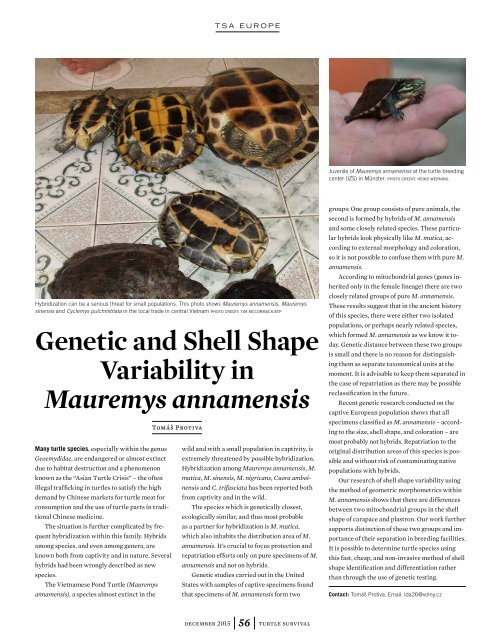Turtle Survival
2tUaeTbNi
2tUaeTbNi
You also want an ePaper? Increase the reach of your titles
YUMPU automatically turns print PDFs into web optimized ePapers that Google loves.
TSA EUROPE<br />
Juvenile of Mauremys annamensis at the turtle breeding<br />
center (IZS) in Münster. PHOTO CREDIT: HEIKO WERNING<br />
Hybridization can be a serious threat for small populations. This photo shows Mauremys annamensis, Mauremys<br />
sinensis and Cyclemys pulchristriata in the local trade in central Vietnam PHOTO CREDIT: TIM MCCORMACK/ATP<br />
Genetic and Shell Shape<br />
Variability in<br />
Mauremys annamensis<br />
Many turtle species, especially within the genus<br />
Geoemydidae, are endangered or almost extinct<br />
due to habitat destruction and a phenomenon<br />
known as the “Asian <strong>Turtle</strong> Crisis” – the often<br />
illegal trafficking in turtles to satisfy the high<br />
demand by Chinese markets for turtle meat for<br />
consumption and the use of turtle parts in traditional<br />
Chinese medicine.<br />
The situation is further complicated by frequent<br />
hybridization within this family. Hybrids<br />
among species, and even among genera, are<br />
known both from captivity and in nature. Several<br />
hybrids had been wrongly described as new<br />
species.<br />
The Vietnamese Pond <strong>Turtle</strong> (Mauremys<br />
annamensis), a species almost extinct in the<br />
Tomáš Protiva<br />
wild and with a small population in captivity, is<br />
extremely threatened by possible hybridization.<br />
Hybridization among Mauremys annamensis, M.<br />
mutica, M. sinensis, M. nigricans, Cuora amboinensis<br />
and C. trifasciata has been reported both<br />
from captivity and in the wild.<br />
The species which is genetically closest,<br />
ecologically similar, and thus most probable<br />
as a partner for hybridization is M. mutica,<br />
which also inhabits the distribution area of M.<br />
annamensis. It’s crucial to focus protection and<br />
repatriation efforts only on pure specimens of M.<br />
annamensis and not on hybrids.<br />
Genetic studies carried out in the United<br />
States with samples of captive specimens found<br />
that specimens of M. annamensis form two<br />
groups: One group consists of pure animals, the<br />
second is formed by hybrids of M. annamensis<br />
and some closely related species. These particular<br />
hybrids look physically like M. mutica, according<br />
to external morphology and coloration,<br />
so it is not possible to confuse them with pure M.<br />
annamensis.<br />
According to mitochondrial genes (genes inherited<br />
only in the female lineage) there are two<br />
closely related groups of pure M. annamensis.<br />
These results suggest that in the ancient history<br />
of this species, there were either two isolated<br />
populations, or perhaps nearly related species,<br />
which formed M. annamensis as we know it today.<br />
Genetic distance between these two groups<br />
is small and there is no reason for distinguishing<br />
them as separate taxonomical units at the<br />
moment. It is advisable to keep them separated in<br />
the case of repatriation as there may be possible<br />
reclassification in the future.<br />
Recent genetic research conducted on the<br />
captive European population shows that all<br />
specimens classified as M. annamensis – according<br />
to the size, shell shape, and coloration – are<br />
most probably not hybrids. Repatriation to the<br />
original distribution areas of this species is possible<br />
and without risk of contaminating native<br />
populations with hybrids.<br />
Our research of shell shape variability using<br />
the method of geometric morphometrics within<br />
M. annamensis shows that there are differences<br />
between two mitochondrial groups in the shell<br />
shape of carapace and plastron. Our work further<br />
supports distinction of these two groups and importance<br />
of their separation in breeding facilities.<br />
It is possible to determine turtle species using<br />
this fast, cheap, and non-invasive method of shell<br />
shape identification and differentiation rather<br />
than through the use of genetic testing.<br />
Contact: Tomáš Protiva, Email: lda26@volny.cz<br />
december 2015 56 turtle survival


